HOLDS
NO. 12 - THUMB HOLD
This is the most effective hold known, and very little exertion on your part (three to four pounds' pressure) is required to make even the most powerful prisoner obey you. It is possible also for you to conduct him, even if resisting, as far as he is able to walk. You have such complete control of him that you can, if necessary, use him as cover against attack from others.
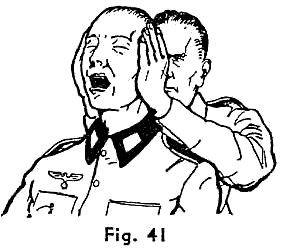 The movements you have to make to secure this hold are very complicated, which is mainly the reason why it is almost unknown outside of the Far East. But the advantage one gains in knowing that he can effectively apply this hold more than repays for the time that must be spent in mastering it.
The movements you have to make to secure this hold are very complicated, which is mainly the reason why it is almost unknown outside of the Far East. But the advantage one gains in knowing that he can effectively apply this hold more than repays for the time that must be spent in mastering it.
First concentrate on making every move slowly, gradually speeding up until all movements become one continuous motion. When you have thoroughly mastered the hold, then learn to secure it from any position in which you have secured your opponent.
It should be understood that this hold is not a method of attack, but simply a "mastering hold," which is applied only after you have partially disabled or brought your opponent to a submissive frame of mind by one of the "follow up" methods (BLOWS).
Should your opponent not be wearing a helmet or similar pro-tection which covers his cars, the following will be found to be a very simple method of making him submissive:
Cup your hands and strike your opponent simultaneously over both ears (Fig. 41). This will probably burst one or both ear drums and at least give him a mild form of concussion. It can be applied from the front or from behind.
NO. 12 - THUMB HOLD (cont.)
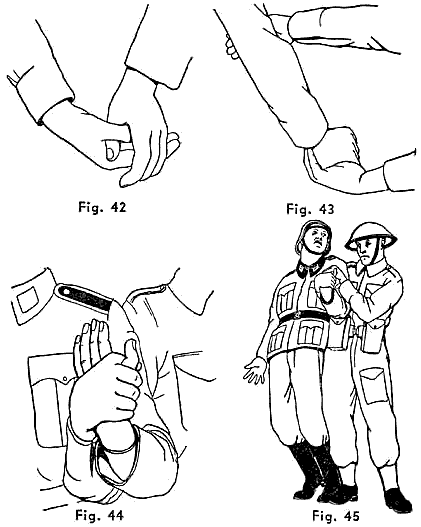 Stand facing your opponent and slightly to his left.
Stand facing your opponent and slightly to his left.
- Insert your right thumb between the thumb and forefinger of his left hand, your fingers under the palm of his hand, your thumb to the right (Fig. 42).
- Seize his left elbow with your left hand, knuckles to the right, and thumb outside and close to your own forefingers (Fig. 43).
- Step in towards your opponent; at the same time, turn your body so that you are facing in the same direction, simultaneously forcing his left forearm up across his chest and towards his left shoulder by pulling his elbow with your left hand over your right forearm and forcing upwards with your right hand (Fig. 44).
Release the hold with your left hand just as soon as you have pulled his elbow over your right forearm, and hold your oppo-nent's left elbow very close to your body. - Keeping a firm grip on the upper part of his left arm with your right arm, immediately seize the fingers of his left hand with your left. This will prevent him from trying to seize one of the fingers of your right hand and also give you an extra leverage for applying pressure as follows:
- Press down on the back of his hand towards your left-hand side with your right hand. Should your opponent be a very-powerful man and try to resist, a little extra pressure applied by pulling his fingers downwards towards your left-hand side with your left hand will be sufficient to bring him up on his toes and convince him that he has met his master (Fig. 45).
O. 13 - SENTRY HOLD
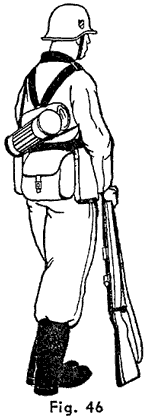 The successful execution of this method of attack on a sentry-presupposing thorough mastery of every move - depends entirely on careful preparation. First, the man selected to make the attack should be an expert at stalking. The stalk or approach should be made during the hours of dark or semi-dark, and the sentry should be kept under observation long enough for the attacker to familiarize himself with the sentry's movements and equipment.
The successful execution of this method of attack on a sentry-presupposing thorough mastery of every move - depends entirely on careful preparation. First, the man selected to make the attack should be an expert at stalking. The stalk or approach should be made during the hours of dark or semi-dark, and the sentry should be kept under observation long enough for the attacker to familiarize himself with the sentry's movements and equipment.
Now let us assume that conditions are somewhat as follows:
- The sentry's rifle is slung or carried on his right shoulder.
- He is wearing a steel helmet covering the back of his neck and his ears.
- He is wearing a respirator on the small of his back, projecting as much as six inches (see Fig. 46).
- There are other sentries within shouting distance.
These conditions are not too favorable for the attacker, but are what might have to be met, and training should be carried out under conditions as near as possible to those which would be met in actual war.
Note. - The stalker should not be handicapped with any equipment, other than a knife or a pistol. He should wear rubber or cloth shoes, socks pulled well up over the trousers, cap-comforter well pulled down, with the collar of his blouse turned up and his hands and face camouflaged (See Fig. 47, page 43).
NO. 13 - SENTRY HOLD (cont.)
- Approach the sentry from behind to within three to four feet and take up the position shown in Fig. 47. This will permit you to make a lightning-like attack by springing on him.
- With the fingers and thumb of your left hand fully extended, strike him across the throat with the inner edge
of your left forearm (i.e. with the forearm bone), and simultaneously punch him with your clenched right hand in the small of his back or on his respirator case (Fig. 48).
The effect of these blows, if applied as above, will render your opponent unconscious or semi-conscious. Further, the blow on the throat will cause your opponent to draw in his breath, making it impossible for him to shout and give the alarm. - The blows should be immediately followed with a very fast movement of your right hand from the small of his back, over his right shoulder, clapping it over his mouth and nose (Fig. 49). This will prevent him from breathing or making a noise if the blow on the throat was not effectively applied.
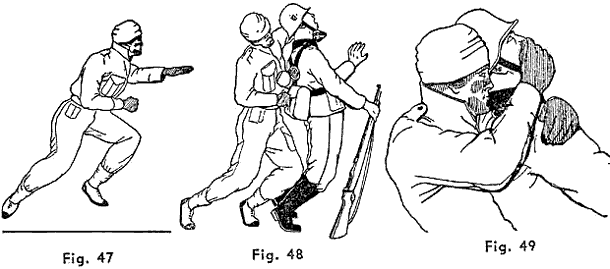
Very likely the blows on his throat and in the small of his back will cause him to drop his rifle or will knock his helmet off his head. Should this happen, do not attempt to prevent their falling on the ground. Just keep still for about ten seconds, after which it is unlikely that anyone having heardthenoise will come to investigate. Retaining your hold around his neck with your left arm, drag him away backwards.
Note. - The extraordinary effectiveness of this hold will be readily understood if you have a friend apply it on you as above, being careful to exert no more than one-twentieth of the required force.
NO. 14 - JAPANESE STRANGLE HOLD
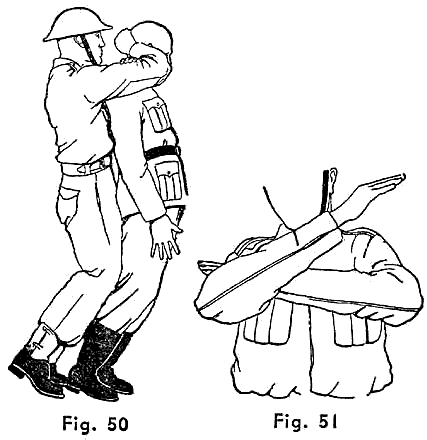
- Aipproach your opponent from behind.
- Place your left arm around his neck, with your forearm bone bearing on his "Adam's apple."
- Place the back of your right arm (above the elbow) on his right shoulder and clasp your right biceps with your left hand.
- Place your right hand on the back of his head.
- Pull him backwards with your left forearm and press his head forward with your right hand, and strangle him (Fig. 50).
Note. - Should your opponent attempt to seize you by the testicles:
(a) Keep your grip with both arms, straightening out the fingers and thumbs of both hands. With the edge of your left hand in the bend of your right arm, place the edge of your right hand just below the base of the skull.
(b) Step back quickly, at the same time jolting his head forward with the edge of your right hand, and dislocate his neck (Fig. 51).
(c) If your opponent is a taller man than yourself, making it difficult for you to reach his right shoulder with your right arm, as in Fig. 50, bend him backwards by applying pressure on his neck with your left arm. If necessary, punch him in the small of the back, as shown in Fig. 48, page 43, and bring him down to your own height.NO. 15 - HANDCUFF HOLD
- You are facing your opponent. Make a dive at his right wrist, seizing it with both hands, right above left, and jerk it violently downwards, as in Fig. 53. This will pro-duce a considerable shock, amounting almost to a knock-out blow on the left side of his head.
- Swing his arm up to the height of your shoulder, at the same time twisting his arm towards you so as to force him off-balance on to his left leg (Fig. 54).
- Keeping his arm at the height of your shoulder, pass quickly underneath it by taking a pace forward with your right foot. (It may be necessary for you to reduce your height to permit your doing this; do so by bending your legs at the knees.) Turn inwards towards your opponent, jerking his arm downwards, as in Fig. 55.
- Step to his back with your left foot, and, with a circular upward motion, force his wrist well up his back. Retain the grip with your left hand and seize his right elbow with your right hand, forcing it well up his back. Then slide your left hand around his wrist, bringing your thumb inside and finger over the back of the hand, and bend his-wrist. Apply pressure with both hands until your oppo--nent's right shoulder points to the ground (Fig. 56).

Note A. - This is a very useful hold for marching your prisoner a short distance only. For a longer march, a change to the Thumb Hold (Fig. 45, page 39) is recommended.
Note B. - A method of tying up your prisoner is shown on page 83 (Figs. 98 and 99).
NO. 16 - BENT-ARM HOLD
Note. - Students are strongly recommended to specialize in mastering this hold.
- Your opponent has taken up a boxing stance, or raised his right arm as if about to deliver a blow.
- Seize his right wrist with your left hand, bending his arm at the elbow, towards him (Fig. 57). Continue the pressure on his wrist until his arm is in the position shown in Fig. 58.
Note. - These movements must be one rapid and continuous motion. Note that forcing your opponent's right forearm backwards places him off-balance, making it almost impossible for him to attack you with his left fist. - Immediately step in with your right foot, placing your right leg and hip close in to your opponent's thigh.
- Pass your right arm under the upper part of his right arm, seizing his right wrist with your right hand above your left.
- Keeping a firm grip with both hands, force his right elbow and arm against your chest, applying pressure by jerking his wrist towards the ground. At the same time, force the forearm bone of your right arm up and in to the back muscles of the upper part of his right arm (Fig. 59).
- Should your opponent, when in this position, attempt to strike you with his left hand: Straighten out the fingers and thumb of your right hand, placing the edge of the hand over your left wrist, and apply pressure by a sudden jerk upwards of your right forearm, taking care to keep his elbow well in to your chest (Fig. 60).
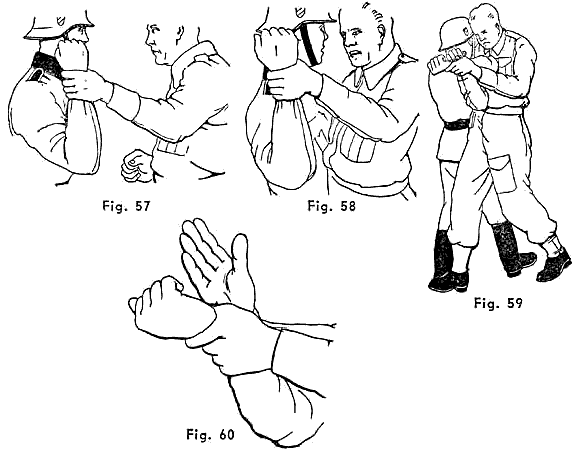
NO. 17 - HEAD HOLD
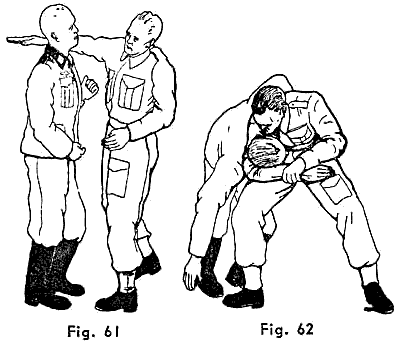 Approach your opponent from the front.
Approach your opponent from the front.
- Keeping the fingers of your right hand straight and thumb extended, strike him on the left side of his neck with the inside of your right forearm (Fig. 61). This blow will render your opponent "punch-drunk" or dazed.
- Immediately after delivering the blow with your right forearm, slide it around your opponent's neck, simultaneously stepping across his front with your right leg, bending him forward from the waist and catching hold of your right wrist with your left hand (Fig. 62).
- Force your right forearm bone into the right side of his face (anywhere between the temple and the chin will do) by pulling on your right wrist with your left hand and forcing downwards on the left side of his face with your body.
Note. - Observe that the outside of your right forearm is resting on your right thigh and that the weight of your body is being forced on to your right leg by pressure from your left foot. Any attempt of your opponent to seize your testicles should immediately be countered by a slight increase of pressure. If necessary, apply an edge-of-the-hand blow as follows: Release your hold with your left hand, straighten up slightly, and apply the blow on the left side of his neck.



